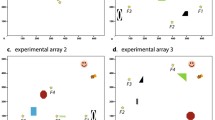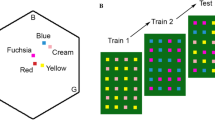Abstract
We presented bumblebees a spatial memory task similar to that used with other species (e.g., cats, dogs, and pigeons). In some conditions we allowed for presence of scent marks in addition to placing local and global spatial cues in conflict. Bumblebees (Bombus impatiens) were presented an array of artificial flowers within a flight cage, one flower offering reward (S+), while the others were empty (S−). Bees were tested with empty flowers. In Experiment 1, flowers were either moved at the time of testing or not. Bees returned to the flower in the same absolute position of the S+ (the flower-array-independent (FAI) position), even if it was in the wrong position relative to the S− and even when new flower covers prevented the use of possible scent marks. New flower covers (i.e., without possible scent marks) had the effect of lowering the frequency of probing behavior. In Experiment 2, the colony was moved between training and testing. Again, bees chose the flower in the FAI position of the S+, and not the flower that would be chosen using strictly memory for a flight vector. Together, these experiments show that to locate the S+ bees did not rely on scent marks nor the positions of the S−, though the S− were prominent objects close to the goal. Also, bees selected environmental features to remember the position of the S+ instead of relying upon a purely egocentric point of view. Similarities with honeybees and vertebrates are discussed, as well as possible encoding mechanisms.




Similar content being viewed by others
References
Brodbeck DR (1994) Memory for spatial and local cues:a comparison of a storing and nonstoring species. Anim Learn Behav 22:119–133
Brodbeck DR, Shettleworth SJ (1995) Matching location and color of a compound stimulus: comparison of a food-storing and a nonstoring bird species. J Exp Psychol Anim Behav Process 21:64–77
Brown MF, Demas GE (1994) Evidence for spatial working memory in honeybees (Apis mellifera). J Comp Psychol 108:344–352
Brown MF, Moore JA, Brown CH, Langheld KD (1997) The existence and extent of spatial working memory ability in honeybees. Anim Learn Behav 25:473–484
Cameron SA (1981) Chemical signals in bumble bee foraging. Behav Ecol Sociobiol 9:257–260
Cartwright BA, Collett TS (1982) How honey bees use landmarks to guide their return to a food source. Nature 295:560–564
Cartwright BA, Collett TS (1983) Landmark learning in bees. J Comp Physiol 151:521–543
Cheng K (1986) A purely geometric module in the rat's spatial representation. Cognition 23:149–178
Cheng K (2000) How honeybees find a place: lessons from a simple mind. Anim Learn Behav 28:1–15
Cheng K, Collett TS, Pickhard A, Wehner R (1987) The use of visual landmarks by honeybees: bees weight landmarks according to their distance from the goal. J Comp Physiol A 161:469–475
Cheng K, Collett TS, Wehner R (1986) Honeybees can learn the colours of landmarks. J Comp Physiol A 159:69–73
Cheng K, Sherry DF (1992) Landmark-based spatial memory in birds (Parus atricapillus and Columba livia): the use of edges and distances to represent spatial positions. J Comp Psychol 106:331–341
Chittka L, Geiger K (1995a) Can honey bees count landmarks? Anim Behav 49:159–164
Chittka L, Geiger K (1995b) Honeybee long-distance orientation in a controlled environment. Ethology 99:117–126
Chittka L, Geiger K, Kunze J (1995) The influences of landmarks on distance estimation of honey bees. Anim Behav 50:23–31
Chittka L, Williams NM, Rasmussen H, Thomson JD (1999) Navigation without vision: bumblebee orientation in complete darkness. Proc Royal Soc Lond B 266:45–50
Collett M, Harland D, Collett TS (2002) The use of landmarks and panoramic context in the performance of local vectors by navigating honeybees. J Exp Biol 205:807–814
Collett TS (1996) Insect navigation en route to the goal: multiple strategies for the use of landmarks. J Exp Biol 199:227–235
Collett TS, Cartwright BA (1983) Eidetic images in insects: their role in navigation. Trends Neurosci 6:101–105
Collett TS, Collett M (2000) Path integration in insects. Curr. Opin. Neurobiol 10:757–762
Collett TS, Fry SN, Wehner R (1993) Sequence learning by honeybees. J Comp Physiol A 172:693–706
Collett TS, Kelber A (1988) The retrieval of visuo-spatial memories by honeybees. J Comp Physiol A 163:145–150
Couvillon PA, Bitterman ME (1991) How honeybees make choices. In: Goodman LJ, Fisher RC (eds) The behaviour and physiology of bees, CAB International, Wallinford, pp 116–130
Dyer FC (1998) Spatial cognition:lessons from central-place foraging insects. In: Balda RP, Pepperberg IM, Kamil AC (eds) Animal cognition in nature:the convergence of psychology and biology in laboratory and field. Academic Press, Toronto, pp. 119–154
Dyer FC, Gould JL (1983) Honey bee navigation. Am Sci 71:587–597
Etienne AS, Joris-Lambert S, Dahn-Hurni C, Reverdin B (1995) Optimizing visual landmarks: two- and three-dimensional minimal landscapes. Anim Behav 49:165–179
Fauria K, Campan R, Grimal A (2004) Visual marks learned by the solitary bee Megachile rotundata for localizing its nest. Anim Behav 67:523–530
Fiset S, Doré FY (1996) Spatial encoding in domestic cats (Felis catus). J Exp Psychol Anim Behav Process 22:420–437
Fiset S, Gagnon S, Beaulieu C (2000) Spatial encoding of hidden objects in dogs (Canis familiaris). J Comp Psychol 114:315–324
Francis B, Green M, Payne C (1993) GLIM: the Statistical System for Generalized Linear Interactive Modelling (Version 4.0) [Computer software manual]. Oxford University Press, New York
Fry SN, Wehner R (2002) Honey bees store landmarks in an egocentric frame of reference. J Comp Physiol A 187:1009–1016
Gallistel CR (1990) The organization of learning. The MIT Press, Cambridge, MA
Giurfa M, Núñez JA (1992) Honeybees mark with scent and reject recently visited flowers. Oecologia 89:113–117
Giurfa M, Núñez JA, Backhaus W (1994) Odour and colour information in the foraging choice behaviour of the honeybee. J Comp Physiol A 175:773–779
Goto K, Wills AJ, Lea SEG (2004) Global-feature classification can be acquired more rapidly than local-feature classification in both humans and pigeons. Anim Cogn 7:109–113
Goulson D, Chapman JW, Hughes WOH (2001) Discrimination of unrewarding flowers by bees: direct detection of rewards and use of repellent scent marks. J Insect Behav 14:669–678
Goulson D, Hawson SA, Stout JC (1998) Foraging bumblebees avoid flowers already visited by conspecifics or by other bumblebee species. Anim Behav 55:199–206
Gray ER, Spetch ML, Kelly DM, Nguyen A (2004) Searching in the center:pigeons (Columba livia) encode relative distance from walls of enclosure. J Comp Psychol 118:113–117
Hartling LK, Plowright RC (1979) Foraging by bumblebees on patches of artificial flowers. Can J Zool 57:1866–1870
Healy SD, Hurly TA (1998) Rufous hummingbirds' (Selasphorus rufus) memory for flowers:patterns or actual spatial locations? J Exp Psychol Anim Behav Process 24:396–404
Huber B, Couvillon PA, Bitterman ME (1994) Place and position learning in honeybees (Apis mellifera). J Comp Psychol 108:213–219
Hurly TA, Healy SD (1996) Memory for flowers in rufous hummingbirds: location or local visual cues? Anim Behav 51:1149–1157
Kato M (1988) Bumblebee visits to Impatiens spp.: pattern and efficiency. Oecologia 76:364–370
Menzel R, Geiger K, Joerges J, Müller U, Chittka L (1998) Bees travel novel homeward routes by integrating separately acquired vector memories. Anim Behav 55:139–152
Schmitt U, Bertsch A (1990) Do foraging bumblebees scent-mark food sources and does it matter? Oecologia 82:137–144
Schmitt U, Lübke G, Francke W (1991) Tarsal secretion marks food sources in bumblebees (Hymenoptera: Apidae). Chemoecol 2:35–40
Shettleworth SJ (1998) Cognition, evolution, and behavior. Oxford University Press, Toronto
Spetch ML, Edwards CA (1988) Pigeons', Columba livia, use of global and local cues for spatial memory. Anim Behav 36:293–296
Stout JC, Goulson D, Allen JA (1998) Repellent scent-marking of flowers by a guild of foraging bumblebees (Bombus spp.). Behav Ecol Sociobiol 43:317–326
Thomson JD, Chittka L (2001) Pollinator individuality:when does it matter? In: Chittka L, Thomson JD (eds) Cognitive ecology of pollination: animal behavior and floral evolution, Cambridge University Press, New York, pp 191–213
Wang RF, Spelke ES (2002) Human spatial representation:insights from animals. Trends Cogn Sci 6:376–382
Wetherwax PB (1986) Why do honeybees reject certain flowers? Oecologia 69:567–570
Williams CS (1998) The identity of the previous visitor influences flower rejection by nectar-collecting bees. Anim Behav 56:673–681
Acknowledgements
This paper was prepared as part of the first author's doctoral thesis. Experiment 1 was presented at the 13th Annual Meeting of the Canadian Society for Brain, Behavior, and Cognitive Science, Hamilton, Ontario, June 2003, and Experiment 2 was presented at the 11th Annual Conference on Comparative Cognition, Melbourne, FL, March 2004. This research was supported by a research grant to C. M. S. P. and a graduate scholarship to D. L. C. from the Natural Sciences and Engineering Research Council of Canada. We thank Alain Desrochers, Sylvain Fiset, Sylvain Gagnon, Pierre Mercier, and three anonymous reviewers for their constructive comments. All experiments comply with the standards of the Canadian Council on Animal Care.
Author information
Authors and Affiliations
Corresponding author
Rights and permissions
About this article
Cite this article
Church, D.L., Plowright, C.M.S. Spatial encoding by bumblebees (Bombus impatiens) of a reward within an artificial flower array. Anim Cogn 9, 131–140 (2006). https://doi.org/10.1007/s10071-005-0011-6
Received:
Revised:
Accepted:
Published:
Issue Date:
DOI: https://doi.org/10.1007/s10071-005-0011-6




